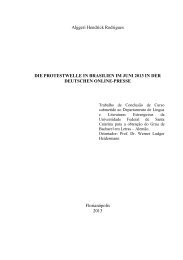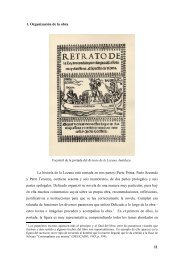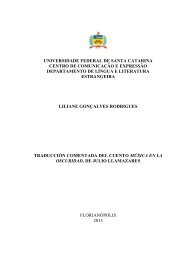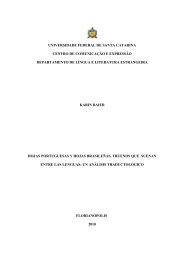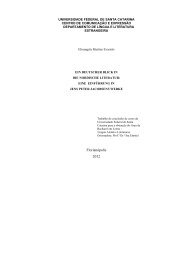TCC - Marcia Regina Barreto Moraes - Departamento de Língua e ...
TCC - Marcia Regina Barreto Moraes - Departamento de Língua e ...
TCC - Marcia Regina Barreto Moraes - Departamento de Língua e ...
You also want an ePaper? Increase the reach of your titles
YUMPU automatically turns print PDFs into web optimized ePapers that Google loves.
INTRODUCTION<br />
Poetry creates its images not only for expressing moods. As a form of literature,<br />
poetry can confuse rea<strong>de</strong>r’s senses and reason. Cleanth Brooks and Robert Penn Warren<br />
point out that poetry allow us (rea<strong>de</strong>rs) to experience “to be alive in the world”, because it<br />
concentrates on “lived fullness of the world”. For them, poetry extends our limits “by<br />
means of imagination”. 1 It is certainly not easy to label poetry. It has as close connection<br />
with music, sometimes represents dreams.<br />
Poems can be disturbing, incoherent or satisfying, pleasant to the rea<strong>de</strong>rs’ senses.<br />
Gaston Bachelard observes that the several images created in poetry are unexpected. The<br />
French theorist explains, according to phenomenology – the study of consciousness –, that<br />
these are “not lived images, (but) images that life does not prepare and poets create” . 2<br />
Like poetry, imaginative prose is product of a creative inner world. It constructs a<br />
unique story and characters. The tale at issue, written by José Saramago, as a work of<br />
fiction, surprises involving us rea<strong>de</strong>rs in an imaginative event: a vassal who wants a boat<br />
to find an unknown island. What can be assumed is that both poetry and prose have an<br />
important social function. In this way, J. Hillis Miller in “Narrative” says that fictions are<br />
necessary for experimenting possibilities “to take our places in the real world, to play our<br />
parts there”. 3<br />
This study explores topics related to travel literature, such as travelers, places,<br />
encounters, in or<strong>de</strong>r to discuss the correspon<strong>de</strong>nces in the works of the Brazilian-Canadian<br />
poet Ricardo Sternberg (Map of Dreams), the Portuguese writer and Nobel Prize winner<br />
José Saramago (The Tale of the Unknown Island), and the Portuguese poet Fernando Pessoa<br />
1 Cleanth Brooks and Robert Penn Warren. “Poetry as a Way of Saying”. Un<strong>de</strong>rstanding poetry (8-9) .<br />
2 Gaston Bachelard. A Poética do Espaço (13-15).<br />
3 J. Hills Miller. “Narrative”. Critical Terms for Literary Study (68-69).<br />
1



